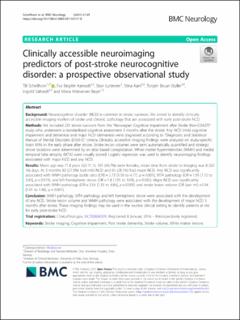| dc.contributor.author | SCHELLHORN, TILL | |
| dc.contributor.author | Aamodt, Eva Birgitte | |
| dc.contributor.author | Lydersen, Stian | |
| dc.contributor.author | Aam, Stina | |
| dc.contributor.author | Wyller, Torgeir Bruun | |
| dc.contributor.author | Saltvedt, Ingvild | |
| dc.contributor.author | Beyer, Mona Kristiansen | |
| dc.date.accessioned | 2021-10-20T07:53:28Z | |
| dc.date.available | 2021-10-20T07:53:28Z | |
| dc.date.created | 2021-09-06T17:12:57Z | |
| dc.date.issued | 2021 | |
| dc.identifier.citation | BMC Neurology. 2021, 21 (1), 1-11. | en_US |
| dc.identifier.issn | 1471-2377 | |
| dc.identifier.uri | https://hdl.handle.net/11250/2824000 | |
| dc.description.abstract | Background
Neurocognitive disorder (NCD) is common in stroke survivors. We aimed to identify clinically accessible imaging markers of stroke and chronic pathology that are associated with early post-stroke NCD.
Methods
We included 231 stroke survivors from the “Norwegian Cognitive Impairment after Stroke (Nor-COAST)” study who underwent a standardized cognitive assessment 3 months after the stroke. Any NCD (mild cognitive impairment and dementia) and major NCD (dementia) were diagnosed according to “Diagnostic and Statistical Manual of Mental Disorders (DSM-5)” criteria. Clinically accessible imaging findings were analyzed on study-specific brain MRIs in the early phase after stroke. Stroke lesion volumes were semi automatically quantified and strategic stroke locations were determined by an atlas based coregistration. White matter hyperintensities (WMH) and medial temporal lobe atrophy (MTA) were visually scored. Logistic regression was used to identify neuroimaging findings associated with major NCD and any NCD.
Results
Mean age was 71.8 years (SD 11.1), 101 (43.7%) were females, mean time from stroke to imaging was 8 (SD 16) days. At 3 months 63 (27.3%) had mild NCD and 65 (28.1%) had major NCD. Any NCD was significantly associated with WMH pathology (odds ratio (OR) = 2.73 [1.56 to 4.77], p = 0.001), MTA pathology (OR = 1.95 [1.12 to 3.41], p = 0.019), and left hemispheric stroke (OR = 1.8 [1.05 to 3.09], p = 0.032). Major NCD was significantly associated with WMH pathology (OR = 2.54 [1.33 to 4.84], p = 0.005) and stroke lesion volume (OR (per ml) =1.04 [1.01 to 1.06], p = 0.001).
Conclusion
WMH pathology, MTA pathology and left hemispheric stroke were associated with the development of any NCD. Stroke lesion volume and WMH pathology were associated with the development of major NCD 3 months after stroke. These imaging findings may be used in the routine clinical setting to identify patients at risk for early post-stroke NCD. | en_US |
| dc.language.iso | eng | en_US |
| dc.publisher | BioMed Central Ltd. | en_US |
| dc.rights | Navngivelse 4.0 Internasjonal | * |
| dc.rights.uri | http://creativecommons.org/licenses/by/4.0/deed.no | * |
| dc.title | Clinically accessible neuroimaging predictors of post-stroke neurocognitive disorder: a prospective observational study | en_US |
| dc.type | Peer reviewed | en_US |
| dc.type | Journal article | en_US |
| dc.description.version | publishedVersion | en_US |
| dc.source.pagenumber | 1-11 | en_US |
| dc.source.volume | 21 | en_US |
| dc.source.journal | BMC Neurology | en_US |
| dc.source.issue | 1 | en_US |
| dc.identifier.doi | 10.1186/s12883-021-02117-8 | |
| dc.identifier.cristin | 1931760 | |
| dc.source.articlenumber | 89 | en_US |
| cristin.ispublished | true | |
| cristin.fulltext | original | |
| cristin.qualitycode | 1 | |

